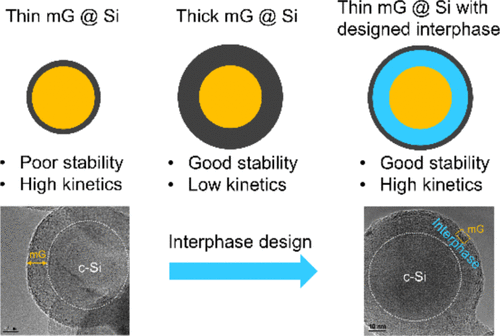当前位置:
X-MOL 学术
›
ACS Appl. Mater. Interfaces
›
论文详情
Our official English website, www.x-mol.net, welcomes your feedback! (Note: you will need to create a separate account there.)
On the interface design of Si and multilayer graphene for high-performance Li-ion battery anode.
ACS Applied Materials & Interfaces ( IF 9.5 ) Pub Date : 2020-09-14 , DOI: 10.1021/acsami.0c13821 Xiang Han 1, 2 , Ziqi Zhang 2 , Huixin Chen 3 , Qiaobao Zhang 4 , Songyan Chen 2 , Yong Yang 5
ACS Applied Materials & Interfaces ( IF 9.5 ) Pub Date : 2020-09-14 , DOI: 10.1021/acsami.0c13821 Xiang Han 1, 2 , Ziqi Zhang 2 , Huixin Chen 3 , Qiaobao Zhang 4 , Songyan Chen 2 , Yong Yang 5
Affiliation

|
Si/multilayer graphene (mG) is a promising candidate for the next-generation Li-ion battery anode. The highly ordered mG shows intrinsic good stability against the liquid electrolyte and its flexibility to accommodate volume change. Until now, reducing the growth temperature and thus engineering the interphase are a very important research area, but only few studies have been reported. Herein, for the first time, the mG is grown with the Al2O3 catalyst at a relatively low temperature of 750 °C, while the thickness is controlled to 2 nm. The growth of mG obeys the Stranski–Krastanov mechanism. Applying a rapid cooling process, a silicon oxycarbide (SiOC) interlayer is in situ-fabricated between the mG coating layer and Si core. The SiOC interlayer is demonstrated to accommodate the volume change of Si and enable faster lithium ion transportation than mG. Taking synergetic advantages of the mG coating layer and SiOC interphase, the cycling stability significantly improved, and a high specific capacity of 990 mA h/g is obtained at 1 A/g after 500 cycles in half cells. A high rate performance of 1164.5 mA h/g at 4 A/g is achieved. Tested in a 1.8 A h pouch cell with LiNi0.5Mn0.3Co0.2O2 (NMC532) as the cathode, the cell delivers a specific energy of ∼380 W h/kg. The capacity retentions are 93% and 78% after 100 cycles and 200 cycles, respectively. Our work highlights the importance of the interphase design of Si/mG composite anodes, which could also be extended to various core–shell materials in energy storage materials.
中文翻译:

高性能锂离子电池阳极硅与多层石墨烯的界面设计。
Si /多层石墨烯(mG)是下一代锂离子电池阳极的有希望的候选者。高度有序的mG对液体电解质显示出固有的良好稳定性,并具有适应体积变化的灵活性。迄今为止,降低生长温度并因此对中间相进行工程设计是一个非常重要的研究领域,但仅报道了很少的研究。在此,mG首次与Al 2 O 3一起生长催化剂在相对较低的750°C温度下,厚度控制在2 nm。mG的生长遵循Stranski-Krastanov机制。采用快速冷却工艺,在mG涂层和Si芯之间原位制造碳氧化硅(SiOC)中间层。事实证明,SiOC中间层可以适应Si的体积变化,并且能够比mG更快地传输锂离子。利用mG涂层和SiOC相间的协同优势,循环稳定性显着提高,并且在半电池中经过500次循环后,在1 A / g的条件下可获得990 mA h / g的高比容量。在4 A / g时可实现1164.5 mA h / g的高倍率性能。在1.8 A h袋式电池中用LiNi 0.5 Mn 0.3 Co 0.2 O 2测试(NMC532)作为阴极,该电池可提供约380 W h / kg的比能。100次循环和200次循环后,容量保留率分别为93%和78%。我们的工作强调了Si / mG复合阳极的相间设计的重要性,该相间设计还可以扩展到储能材料中的各种核壳材料。
更新日期:2020-10-07
中文翻译:

高性能锂离子电池阳极硅与多层石墨烯的界面设计。
Si /多层石墨烯(mG)是下一代锂离子电池阳极的有希望的候选者。高度有序的mG对液体电解质显示出固有的良好稳定性,并具有适应体积变化的灵活性。迄今为止,降低生长温度并因此对中间相进行工程设计是一个非常重要的研究领域,但仅报道了很少的研究。在此,mG首次与Al 2 O 3一起生长催化剂在相对较低的750°C温度下,厚度控制在2 nm。mG的生长遵循Stranski-Krastanov机制。采用快速冷却工艺,在mG涂层和Si芯之间原位制造碳氧化硅(SiOC)中间层。事实证明,SiOC中间层可以适应Si的体积变化,并且能够比mG更快地传输锂离子。利用mG涂层和SiOC相间的协同优势,循环稳定性显着提高,并且在半电池中经过500次循环后,在1 A / g的条件下可获得990 mA h / g的高比容量。在4 A / g时可实现1164.5 mA h / g的高倍率性能。在1.8 A h袋式电池中用LiNi 0.5 Mn 0.3 Co 0.2 O 2测试(NMC532)作为阴极,该电池可提供约380 W h / kg的比能。100次循环和200次循环后,容量保留率分别为93%和78%。我们的工作强调了Si / mG复合阳极的相间设计的重要性,该相间设计还可以扩展到储能材料中的各种核壳材料。



























 京公网安备 11010802027423号
京公网安备 11010802027423号